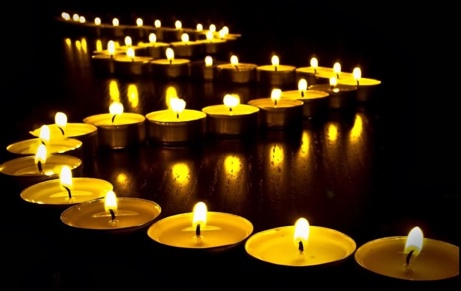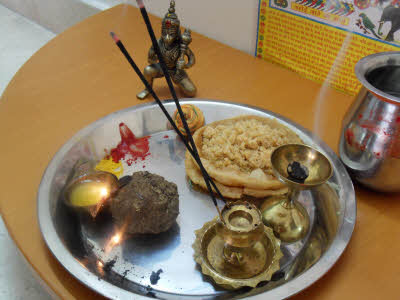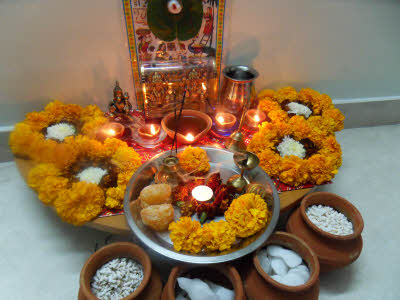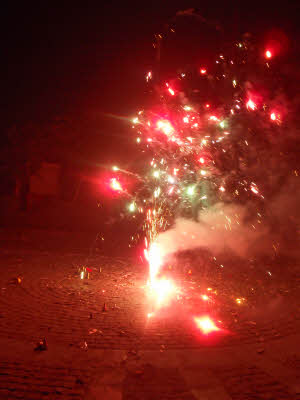| Deepawali is popularly known as the festival of lights. For Hindus, Deepawali is the most important festival of the year. Deepawali means the row of earthen lamps. It’s celebrated by lighting the rows of earthen lamps in the house. The most popular story is that on this day Lord Rama came back to his kingdom after fourteen years of exile so his people welcomed him by lighting a lot of lamps. It is celebrated on the amavas (new moon) of the Kartik month of the Hindu calendar. |
 |
|
The celebrations last for 5 days.
Day 1: Dhanteras |
| Dhanteras Dhanteras is the first day of celebration. This day is also referred to as Dhanwantari Triodasi or Dhantrayodashi. According to the Hindu Calendar, Dhanteras is celebrated on the thirteenth day of the month of Kartik. As per western calendar, Dhanteras usually falls in the month of October or November. Dhan refers to wealth and teras means the thirteenth day. Therefore, Dhanteras is literally translated as the wealth on the thirteenth day. On this day, prayers are offered to Goddess Lakshmi, asking for her blessings in the form of the wealth. Since Dhanteras is considered to be auspicious with regard to the wealth and prosperity, the purchase of a precious metal is said to bring good luck to the home. Women buy gold or silver ornaments on this day. If this is not possible, they at least buy a new utensil for the kitchen. Alpana or Rangoli designs are drawn on the pathways including the footprints of the Goddess to mark the arrival of Lakshmi. |
| Choti Deepawali The next day is called Choti Deepawali. On Choti Deepawali, two earthen lamps with ghee (clarified butter) are lit at dusk in front of the pooja in the memory of the forefathers. At least seven more earthen lamps with mustard oil are lit, one for each room of the house and rest for outside. |
| Deepawali Next day is Deepawali. This is the main day of the festivities. In the morning, Hanuman pooja is performed. You need Churma (a hearty sweet made out of poode), two puris, a desi ghee lamp, incense sticks, dhoop, sindoor, a thali (a big plate), a small pitcher for water and a dry piece of cow dung. Some Churma is put on the puris and puris are kept in the thali. Rest of the Churma is kept in a bowl on the side to be distributed as Prasad in the end. A thin paste is made out of Sindoor and water in the thali. A Hindu Swastika is made on the water pitcher with the Sindoor paste. The sacred thread Kalava is tied on the pitcher. Desi ghee lamp is lit, its flame touching the dry cow dung and kept in thali. This is called Agni Pooja (worshipping fire). All men lit incense stick and dhoop, do Hanuman tilak with the Sindoor paste, sprinkle some Sindoor paste on the puris, offer some ghee to the cow dung, offer Churma and water to Hanumanji and bow. Hanuman Chalisa, Sankat Mochan and Hanuman Aarti are sung. All men tilak themselves with the ash of the burnt cow dung and bow in front of the idol of Hanuman. Puris and Churma from the thali are offered to a cow. Rest of the Churma is eaten by the family members as Prasad. Pakka Khana (puri, kachori and curries) are prepared for lunch. |
 |
| Deepawali Evening
In the evening, Goddess Lakshmi is worshiped. A lot of things are needed for the pooja: Kheel (puffed wheat), batashe (sweet made of sugar only), sugar toys (toys made of sugar), regular sweets, flour dough, beetle leaf, silver coin, Hoyi paper (used in Hoyi Pooja) for the wall, kalava (the sacred pooja thread), idols of Lakshmi and Ganesh, a new utensil, new postcards, incense sticks, a big earthen lamp (saurati ka diya), red paper, Ganges water, tulsi (basil) leaves, a low stool (chauki), a pooja thali (a big plate), Roli, rose water, many small earthen lamps and flowers for decoration. |

|
| Hoyi paper is stuck to the wall (if you celegrate Hoyi, you would have done it then, otherwise do it now). The chauki is placed in front of the Hoyi on the wall. It is covered with red paper or cloth as red is considered auspicious. The idols of Lakshmi and Ganesh are placed in the middle of the chauki. The beetle leaf is stuck on the Hoyi paper using the dough. Roli is kept in pooja thali and a thin paste is made with the help of the water. A Hindu Swastika is made on the Hoyi paper with the roli paste. Shubh Labh (good profit) and shri mahalakshmiji sada sahay is also written on the Hoyi paper. Silver coin in washed in a new vessel using the Ganga water and then it’s stuck on the beetle leaf using the dough. Then a batasha is stuck on the coin using the dough. In the new vessel, 5 batashe, some kheel, tulsi and rose water is mixed to make charnamrita. |
 |
|
Then the lamps are lit and incense sticks are burnt. Kheel and batashe are offered to the idols, roli paste is sprinkled on the idols and then water is sprinkled. Lakshmi Aarti is sung. Some roli paste is sprinkled on the postcards too. Postcards can be mailed to friends or relatives. Five handful kheel, batashe and sweet toys are separated out for the fore fathers and given to the poor.
Everybody bows in front of the idols, drink a spoonful of charnamrita and eats kheel, batashe and sweets. At night before sleeping, an empty earthen lamp is kept on top of the burning lamp so that it gets burnt, to be used as kajal later at night. After Lakshmi Pooja, everybody goes out and lights the fire crackers. |
 |
| Annakoot The next day of Badi Deepawali, Annakut is made for lunch. Annakut is nothing but a vegetable made out of a lot of raw vegetables, as many as you can find. The vegetable is eaten with roti, rice and dal. |
| Bhai Dooj The next day is called Bhai Dooj. On Bhai Dooj, the sisters do Tilak to their brothers with roli and rice and pray for their long lives. They offer Nariyal and sweets to their brothers. Brothers in turn give them some gift. And this concludes all the Deepawali festivities. |
| Significance On Deepawali we clean our houses thoroughly, light the lamps, meet our friends, distribute sweets, start new ledgers and pray for the wealth. At the spiritual level all these things actually mean something very different. Cleaning of houses signifies cleaning our thoughts and belief systems of any negativity we have. Lighting the lamps signifies lighting the internal lamp, meaning reminding ourselves that we are nothing but a soul (point of light) in a body. When we become soul conscious, we think beyond the materialistic bodily things, which solves most of our problems. Meeting people and distributing sweets signifies blessing other souls and spreading happiness. Starting new ledger means closing our old karmic accounts and starting the new ones by forgiving all those who did something wrong to us and starting with a clean account. Praying to Lakshmi for wealth means praying for the wealth of knowledge. If we really think about it, Deepawali is much more than a festival of lights. So let’s try to inculcate some of these things in our lives and change it for the better. |
Deepawali
Written By: Ruchi
-
Nov•
02•13